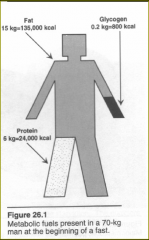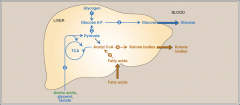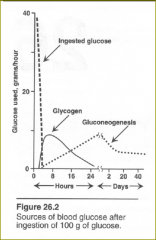![]()
![]()
![]()
Use LEFT and RIGHT arrow keys to navigate between flashcards;
Use UP and DOWN arrow keys to flip the card;
H to show hint;
A reads text to speech;
14 Cards in this Set
- Front
- Back
- 3rd side (hint)
|
absorptive state is ____ hours after a meal.
|
2-4
catabolism = |
increased degradation of glycogen, triacylglycerol and protein
Characteristics: A decrease in plasma glucose, triacylglycerol and amino acids A decrease in secretion of insulin and an increase in secretion of glucagon by β-cells in pancreas |
|
|
metabolic fuels: =
|
glucose
ketone bodies |

Fuel store at the beginning of a fast
|
|
|
4 mechanisms control metabolic flux:
|
1. Availability of substrates ( time = )
2. Allosteric activation and inhibition of enzymes () 3. Covalent modification of enzymes (minutes to hours) phosphorylation kinases (either serine threonine, or tyrosine) and dephosphorylation by phosphatases. 4. induction or repression of enzyme synthesis( =) can be transcriptional or post-transcriptional regulation |
minutes
minutes minutes to hours (hours to days) |
|
|
Insulin metabolism
Plasma half-life: |
3 - 6 min.
Circulates as free ---_______ |
Distribution volume approximates that of the extracellular fluid
monomer |
|
|
In the starved state, most of the enzymes are in the phosphorylated form and are inactive. Three enzymes are exceptions:
|
- Glycogen phosphorylase
- Fructose bisphosphate phosphatase2 -Hormone sensitive lipase |

|
|

Primary role of liver during fasting is synthesis and distribution of fuel molecules
|
(glucose and ketone bodie
|
|
|

Liver in fasting
Carbohydrate metabolism - liver |
- Increased glycogen degradation
- Increased gluconeogenesis |
|
|
|
- Increased glycogen degradation
|
Glucagon (or epinephrine) ------> protein kinase A
------> glycogen phosphorylase kinase (+P) (active) ------> glycogen phosphorylase (+P) (active) ------> glycogen degradation |
------>
|
|
|
- Increased gluconeogenesis
|
Glucagon (or epinephrine)
------> protein kinase A ------> pyruvate kinase (+P) (inactive) glycolysis. Glucagon ------> PEP carboxykinase mRNA ------> PEP |
|
|
|
Fat metabolism - liver
|
- Increased fatty acid oxidation
- Increased synthesis of ketone bodies |

|
|
|
Adipose tissue in fasting
Carbohydrate metabolism - adipose - Glucose transport into the adipocyte and the subsequent glucose metabolism are depressed due to a low level of _____=. |

insulin
|
|
|
|
Adipose tissue in fasting
Fat metabolism - adipose - Low glucose uptake leads to a decrease of fatty acid and TAG synthesis |
fatty acid and TAG synthesis
- Increased degradation of = - Increased release of = - Decreased uptake of = |
TAGs
fatty acids fatty acids |
|
|
Adipose tissue in fasting
Fat metabolism - adipose |
- Low glucose uptake leads to a decrease of fatty acid and TAG synthesis
- Increased degradation of TAGs Glucagon (or epinephrine) protein kinase A hormone sensitive lipase (+P) (active) - Increased release of fatty acids Glucagon (or epinephrine) protein kinase A acetyl CoA carboxylase (+P) (inactive) lipogenesis - Decreased uptake of fatty acids |

|
|
|
During the first two weeks of fasting, muscle uses fatty acids (from adipose) and ketone bodies (from liver) as fuels.
After three weeks, muscle decreases its use of ketone bodies and fatty acids are the major fuel. |

|
|

